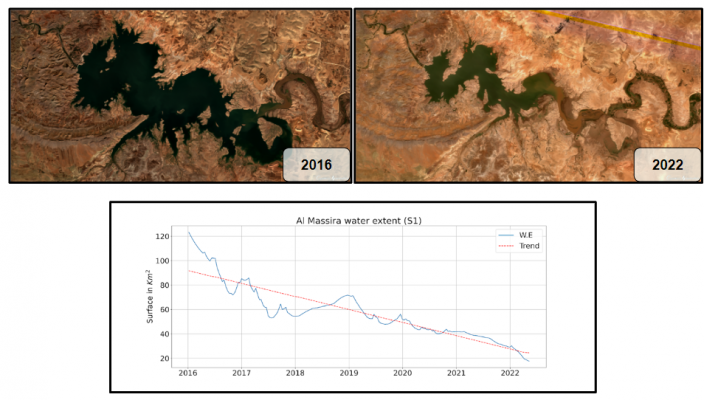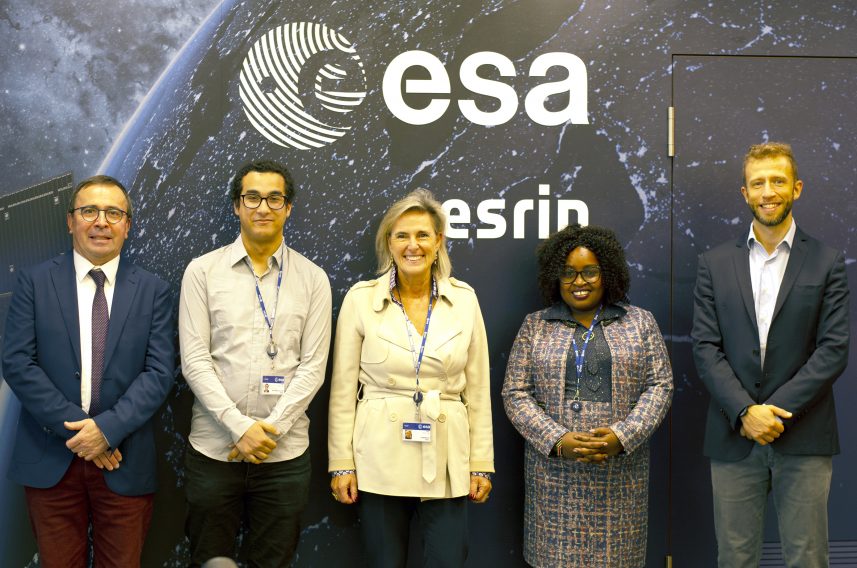In the framework of the overall collaborative efforts with Africa, carried out with the strong involvement of the African Union Commission (AUC), for the first time in the ESRIN activities, two African Researchers have joined ESRIN in 2022: Dr. Wassim M. Baba and Dr Gladys Mosomtai.
Wassim a post-doctoral researcher at the University Mohammed VI Polytechnic (UM6P) Bengurir, Morocco, is working on the monitoring of snow cover dynamics in the High Atlas Mountain (Morocco) by modelling and remote sensing. During his stay in ESRIN he is analysing “African water dynamics using remote sensing data”, with the aim to develop a NRT monitoring workflow/system of water dynamics in terms of surface and heights, based on multi-source EO data. The focus is initially on the Moroccan lakes and reservoirs and subsequently on the applicability testing in the African continent.

Gladys came to ESRIN after having submitted her PhD thesis at the University of KwaZulu-Natal, South Africa and International Centre of Insect Physiology and Ecology, Kenya. Her fellowship research in ESRIN aims to understand the role of livestock migration pattern in the transmission of Rift Valley Fever disease, a zoonotic disease with global importance. The study integrates telemetry data, mosquito vectors that mainly transmit the disease and serological data that show the exposure of the animals to the virus along their migratory routes with rangeland characterization from Sentinel 2/Landsat 8. The study aims to fill an important literature gap on the role of cattle movement in the transmission and maintenance of Rift Valley Fever virus.
The two fellows joined ESA in the context of the wider EO AFRICA initiative, which addresses the sustainable adoption of Earth Observation and related space technology in Africa, by empowering the new generation of African researchers to develop innovative and reliable evidence-based solutions specifically for food-security and water management efforts. Driven by African user needs, EO AFRICA follows a long-term vision (>10 years) for the emergent digital era in Africa and builds on the experience and the network of African experts developed during ESA’s past TIGER Initiative (2002-2019).
EO AFRICA has initiated since 2021 many activities involving African national authorities, institutions and the private sector to tackle research, applications and operational needs identified by African users and stakeholders.
In March 2021 the ESA-funded EO AFRICA R&D facility begun its activities under the advice of an African board of experts from SANSA, The University of Energy and Natural Resources of Ghana, AARSE and RCMRD. The Facility offers Capacity Building actions for Africans in the form of free training materials, Webinars, MOOCs and online and Face to Face training courses. In addition it supports ongoing R&D projects and is a driving force for the consolidation and empowerment of the EO AFRICA EO community.
Furthermore, following a competitive selection process, in May 2022 a first group of 15 R&D projects involving tandem African–European collaborative teams was selected in cooperation with the African Union Commission. The activities carried by the African Researchers are facilitated by the “Innovation Lab”, a cloud platform developed by the R&D Facility and conceived to boost their work. The platform offers tools to access data and high-level products, open-source codes (algorithms, models, tools) and a customizable data analysis environment to develop EO applications. A second call for proposals has just been released to involve up to 16 additional research teams with a submission deadline on 15 November.
In parallel, ESA has also initiated a number of R&D projects. The first is a Continental Demonstrator to exploit high resolution EO data from the Sentinels over Africa to measure rangeland indicators systematically and accurately.
And starting from September 2022, 10 new projects are being kicked off, involving African developers, research groups and early adopters:
- The six EO AFRICA ‘Explorers’ projects aim to develop and validate EO analysis techniques addressing water resources management and food security matters exploiting thermal and hyperspectral data sources. In particular the projects focus on the unique spatial, spectral and temporal characteristics of NASA’s ECOSTRESS thermal sensor and ASI PRISMA hyperspectral sensor to develop novel methods addressing the growing challenges affecting water resource management and food security in Africa.
- The four EO AFRICA ‘National Incubators’ projects investigate how sustainable agriculture and/or drought monitoring at a national scale can be achieved in the African continent, by co-developing innovative EO-based solutions with African experts.
The image below provides the list of Explorers and National Incubators


